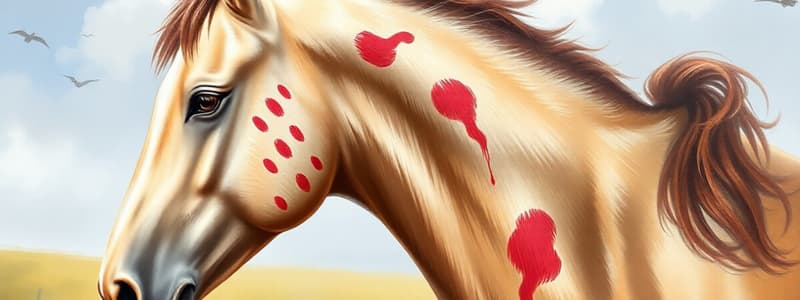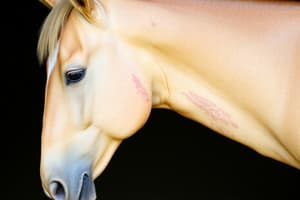Podcast
Questions and Answers
What is a key aspect to consider when diagnosing skin lesions in horses?
What is a key aspect to consider when diagnosing skin lesions in horses?
- The age of the horse is the only relevant factor.
- Only the history of the lesion's growth.
- The possible presence of other lesions and their locations. (correct)
- All lesions are likely sarcoids.
Which of the following is NOT commonly used to describe a skin lesion?
Which of the following is NOT commonly used to describe a skin lesion?
- Hyperkeratotic
- Neoplastic (correct)
- Alopecic
- Verrucous
What would be an important question to ask an owner regarding a skin lesion?
What would be an important question to ask an owner regarding a skin lesion?
- Is the lesion painful to touch? (correct)
- Is the horse receiving regular exercise?
- How many horses are in the area?
- Has the horse recently changed its diet?
Which condition involves a thickening of the epidermis as a potential diagnosis for skin lesions?
Which condition involves a thickening of the epidermis as a potential diagnosis for skin lesions?
What is an important factor in the assessment of skin lesions in horses?
What is an important factor in the assessment of skin lesions in horses?
What might a thickened, verrucous central area of a lesion suggest?
What might a thickened, verrucous central area of a lesion suggest?
The slow and gradual growth of a skin lesion in horses may indicate what?
The slow and gradual growth of a skin lesion in horses may indicate what?
What is a common misconception about skin lesions in horses?
What is a common misconception about skin lesions in horses?
What is the primary aim of using lime sulphur spray/dip?
What is the primary aim of using lime sulphur spray/dip?
Which of the following is NOT a potential cause of pastern dermatitis?
Which of the following is NOT a potential cause of pastern dermatitis?
What is the treatment of choice for melanoma when lesions are small?
What is the treatment of choice for melanoma when lesions are small?
What is an important caution regarding melanomas?
What is an important caution regarding melanomas?
Which diagnostic method is used to assess atypical melanocytes in suspected melanoma cases?
Which diagnostic method is used to assess atypical melanocytes in suspected melanoma cases?
What type of organism is dermatophytosis (ringworm)?
What type of organism is dermatophytosis (ringworm)?
Which of the following is an example of a neoplasm that should be considered when diagnosing skin masses?
Which of the following is an example of a neoplasm that should be considered when diagnosing skin masses?
What common misconception is associated with benign neglect regarding melanomas?
What common misconception is associated with benign neglect regarding melanomas?
What is the primary differential diagnosis for the pony's intense pruritus?
What is the primary differential diagnosis for the pony's intense pruritus?
Which of the following environmental factors should be evaluated for their role in the pony's condition?
Which of the following environmental factors should be evaluated for their role in the pony's condition?
What treatment is suggested to reduce exposure to the inciting cause of pruritus in the pony?
What treatment is suggested to reduce exposure to the inciting cause of pruritus in the pony?
Which anti-inflammatory medication is mentioned for use in treatment?
Which anti-inflammatory medication is mentioned for use in treatment?
What precaution should be considered when using steroid therapy in treatment?
What precaution should be considered when using steroid therapy in treatment?
When is the optimal time to start control measures for midges?
When is the optimal time to start control measures for midges?
What diagnostic method is used to check for other potential allergens affecting the pony?
What diagnostic method is used to check for other potential allergens affecting the pony?
What is a possible indicator of an ongoing louse infestation in the pony?
What is a possible indicator of an ongoing louse infestation in the pony?
What is a disadvantage of laser surgery mentioned?
What is a disadvantage of laser surgery mentioned?
Which treatment is considered the best option for peri-ocular sarcoids?
Which treatment is considered the best option for peri-ocular sarcoids?
What is a potential risk when using intralesional chemotherapy?
What is a potential risk when using intralesional chemotherapy?
What characteristic of cryotherapy is highlighted in the content?
What characteristic of cryotherapy is highlighted in the content?
What type of reaction is associated with the efficacy of topical therapeutic agents?
What type of reaction is associated with the efficacy of topical therapeutic agents?
What should be considered about the cost of radiotherapy?
What should be considered about the cost of radiotherapy?
Which question would be least relevant to ask the owner of the pony concerning pruritus?
Which question would be least relevant to ask the owner of the pony concerning pruritus?
What might be a consequence of the pony's prolonged scratching?
What might be a consequence of the pony's prolonged scratching?
Which treatment option is considered suitable for nodular sarcoids without a root?
Which treatment option is considered suitable for nodular sarcoids without a root?
What is a major benefit of chemotherapy or electrochemotherapy in treating sarcoids?
What is a major benefit of chemotherapy or electrochemotherapy in treating sarcoids?
What is a downside of performing sharp surgery on sarcoids?
What is a downside of performing sharp surgery on sarcoids?
Which treatment option can be very effective when used intradermally but is difficult to acquire?
Which treatment option can be very effective when used intradermally but is difficult to acquire?
What does 'benign neglect' imply in the treatment of sarcoids?
What does 'benign neglect' imply in the treatment of sarcoids?
What is a common complication associated with cryotherapy?
What is a common complication associated with cryotherapy?
Which of the following statements about periocular sarcoids is true?
Which of the following statements about periocular sarcoids is true?
What is a limitation of using ligation as a treatment for sarcoids?
What is a limitation of using ligation as a treatment for sarcoids?
What is the primary diagnostic method that offers rapid results for identifying Trichophyton equinum and Trichophyton mentagrophytes?
What is the primary diagnostic method that offers rapid results for identifying Trichophyton equinum and Trichophyton mentagrophytes?
What should be done before applying Enilconazole washes for treating a horse with fungal infections?
What should be done before applying Enilconazole washes for treating a horse with fungal infections?
What is a significant characteristic of exuberant granulation tissue in horses?
What is a significant characteristic of exuberant granulation tissue in horses?
Which treatment method is NOT typically associated with the management of proud flesh?
Which treatment method is NOT typically associated with the management of proud flesh?
What is a key benefit of maintaining effective record keeping during dermatological exams in horses?
What is a key benefit of maintaining effective record keeping during dermatological exams in horses?
Which condition must be differentiated from proud flesh during diagnosis?
Which condition must be differentiated from proud flesh during diagnosis?
What is the recommended interval for applying Enilconazole washes on horses?
What is the recommended interval for applying Enilconazole washes on horses?
What common misconception exists regarding the treatment of exuberant granulation tissue?
What common misconception exists regarding the treatment of exuberant granulation tissue?
Flashcards
Dermatitis
Dermatitis
A condition that causes bumps, thickening and/or inflammation of the skin. Can have a wide range of causes, from allergies to infections to autoimmune diseases.
Melanoma
Melanoma
A type of skin cancer that typically arises from melanocytes, which are cells that produce melanin (pigment).
Sarcoid
Sarcoid
A type of tumor that can occur on the skin, but can also affect other body tissues. They are benign, meaning they are not cancerous and don't spread.
Exuberant Granulation Tissue
Exuberant Granulation Tissue
Signup and view all the flashcards
Systematic Approach
Systematic Approach
Signup and view all the flashcards
Differential Diagnoses
Differential Diagnoses
Signup and view all the flashcards
Duration of Symptoms
Duration of Symptoms
Signup and view all the flashcards
Pruritic
Pruritic
Signup and view all the flashcards
Laser Surgery
Laser Surgery
Signup and view all the flashcards
Radiotherapy
Radiotherapy
Signup and view all the flashcards
Topical Chemotherapeutic Agents
Topical Chemotherapeutic Agents
Signup and view all the flashcards
Intralesional Chemotherapy
Intralesional Chemotherapy
Signup and view all the flashcards
Electrochemotherapy
Electrochemotherapy
Signup and view all the flashcards
Cryotherapy
Cryotherapy
Signup and view all the flashcards
Self-Induced Alopecia
Self-Induced Alopecia
Signup and view all the flashcards
Sharp Resection
Sharp Resection
Signup and view all the flashcards
Chemotherapy/Electrochemotherapy
Chemotherapy/Electrochemotherapy
Signup and view all the flashcards
Ligation/Banding
Ligation/Banding
Signup and view all the flashcards
Photodynamic therapy
Photodynamic therapy
Signup and view all the flashcards
Benign Neglect
Benign Neglect
Signup and view all the flashcards
Immune Modulation
Immune Modulation
Signup and view all the flashcards
Sweet Itch
Sweet Itch
Signup and view all the flashcards
Culicoides Midges
Culicoides Midges
Signup and view all the flashcards
Intradermal Skin Test
Intradermal Skin Test
Signup and view all the flashcards
Dermatophilosis/Rain Scald
Dermatophilosis/Rain Scald
Signup and view all the flashcards
Dermatophytosis/Ringworm
Dermatophytosis/Ringworm
Signup and view all the flashcards
Alopecia
Alopecia
Signup and view all the flashcards
Management Changes for Sweet Itch
Management Changes for Sweet Itch
Signup and view all the flashcards
Pastern Dermatitis
Pastern Dermatitis
Signup and view all the flashcards
Dermatophytosis (Ringworm)
Dermatophytosis (Ringworm)
Signup and view all the flashcards
Surgical Removal (Melanoma)
Surgical Removal (Melanoma)
Signup and view all the flashcards
Thermochemistry (Melanoma)
Thermochemistry (Melanoma)
Signup and view all the flashcards
Autologous Vaccine (Melanoma)?
Autologous Vaccine (Melanoma)?
Signup and view all the flashcards
Intralesional Chemotherapy (Melanoma)
Intralesional Chemotherapy (Melanoma)
Signup and view all the flashcards
Benign Neglect (Melanoma)
Benign Neglect (Melanoma)
Signup and view all the flashcards
Ringworm in Horses
Ringworm in Horses
Signup and view all the flashcards
Fungal qPCR
Fungal qPCR
Signup and view all the flashcards
Enilconazole
Enilconazole
Signup and view all the flashcards
Proud Flesh
Proud Flesh
Signup and view all the flashcards
Location of Proud Flesh
Location of Proud Flesh
Signup and view all the flashcards
Urticaria (Hives) in Horses
Urticaria (Hives) in Horses
Signup and view all the flashcards
Dermatological Exam
Dermatological Exam
Signup and view all the flashcards
Pre-purchase Exam
Pre-purchase Exam
Signup and view all the flashcards
Study Notes
Equine Dermatology Engagement Session
- Dr Alissa Cooper led the session
- She has a BSc, BVetMed, PGCertVetEd, FHEA, and MRCVS qualifications
- She is a lecturer in equine clinical practice at the University of Surrey
Learning Objectives
- Discuss the presentation, diagnosis, and treatment for sarcoids in horses
- Discuss the presentation, diagnosis, and treatment for dermatitis in horses
- Discuss the presentation, diagnosis, and treatment for melanoma in horses
- Discuss the pathogenesis, diagnosis, and treatment for exuberant granulation tissue in horses
Case Study 1
- A 12-year-old Haflinger gelding presented with a skin lesion on its right caudal abdomen
- The lesion had been present for two years, showing slow and gradual growth
- The lesion's diameter increased gradually, and recently developed more thickening in the center
- Questions to ask the owner include whether the lesion is itchy, location of additional lesions, if other horses are affected, previous treatments, known causes, recent changes, and general health/preventative health
- The lesion is well-circumscribed, alopecic, and has epidermal thickening, hyperkeratosis, verrucous change centrally, pigment change, and lichenification
- Differential diagnoses include sarcoid (occult/verrucous-mixed), dermatophytosis, scar, chronic skin irritation/rubbing, and autoimmune disease
- Diagnostics to consider are skin scrape/hair pluck to rule out other differentials, skin biopsy (incisional or excisional), and awareness of potential risks of making the condition worse
- A treatment plan must be developed
- Treatment options for sarcoid include topical therapy (AW5 cream, imiquimod, 5-fluorouracil), surgery (ligation/banding, laser surgery, sharp resection), chemotherapy/electrochemotherapy, radiotherapy, cryotherapy, immune modulation, photodynamic therapy, and benign neglect
- Periocular sarcoids may require topical/surgical treatment, with skin expanders potentially necessary for reconstruction of the lid
- Intralesional therapy using BCG can be effective but can be difficult to acquire
- Radiation is also possible
- Owners should be warned that treatment may be a long and difficult process, with some cases showing surprising success. Invasive fibroblastic lesions on the muzzle may be targeted with cryotherapy and intralesional 5FU
- Note that surgical removal is usually the best treatment if lesions are still small
Case Study 2
- A 10-year-old Welsh pony mare presented with intense pruritus during the summer, increasingly severe over three seasons
- The pony scratches its rump, tail, and mane, resulting in self-induced alopecia and excoriations
- Similar lesions are noted on the mane
- Questions to ask the owner include how long they've owned the horse, its current management (stabled/turned out), turnout conditions, rug use, topical shampoos, diet, parasite control history, and previous treatments
- Differential diagnoses include Culicoides hypersensitivity (sweet itch), dermatophilosis (rain scald), dermatophytosis (ringworm), contact hypersensitivity, hypersensitivity to other flies/insects, and louse infestation
- Diagnostics include clinical presentation evaluation, environment evaluation (stagnant water for midge breeding), hair plucks, skin scrapes, scurf examination, rule out of ectoparasites, intradermal skin test, checks for/rule out other allergens, and a biopsy
- Management involves management changes to control or reduce exposure to the inciting cause (fly rugs/masks, fly repellent), moving field during summer, stabling during dawn and dusk, fans in stable, starting control measures before midge season, and other options such as SSS/lotions/baths
- Treatment may include medications to reduce pruritus severity like anti-inflammatories (prednisolone/dexamethasone), avoiding long-term steroid use, and considering laminitis risk. Antihistamines also may be helpful
- Desensitization therapy and nutritional supplements may also be considered
Case Study 3
- A 6-year-old cob gelding presented with pruritus to distal limbs
- The signs developed after a move to new yards in September
- The horse stamps its feet, rubs its legs, and bites its pasterns
- No previous history of skin conditions
- Questions to ask the owner include details about the timing, symptoms progression, history of skin conditions/past treatments, and other animals/environment that may be in contact with the horse
- Lesions are described as diffuse, alopecic, erythematous, with scurfy scales and exudate, skin thickening, and pruritic.
- Diagnostic approach involves a skin scrape, sticky tape impression, hair plucks for fungal rule out, and biopsy.
- Preliminary diagnosis includes chorioptic mange (Chorioptes bovis), skin dwelling/scurf feeding mite, and more prevalent in house horses; consideration that the outbreak can be caused by shared equipment
- Management advice includes clipping hair, removing bedding, cleaning and disinfecting the stable daily, treating contact animals, a pig oil/white mineral oil and yellow sulfur patch test, and stopping sharing equipment.
- Treatment includes thorough cleaning with appropriate shampoo (keratolytic or selenium sulfide). Historically, Doramectin (Dectomax injection) may be given, and topical treatments such as Fipronil spray (effective if clipped) and Ivermectin/moxidectin
- Further management may also involve lime sulfur spray, repeated every 7-14 days
Case Study 4
- A 12-year-old grey Connemara mare presented with several nodular masses in the perineal region, gradually increasing in size over 6-8 months.
- Clinical examination revealed additional nodules in the right groin region and a swelling in the left parotid region.
- Differential diagnoses include melanomas, sarcoids, and mast cell tumors
- Diagnostics involve fine needle aspiration (FNA) to identify pleomorphic and atypical melanocytes, and biopsy to confirm atypical melanocytes
- Melanoma treatment options include surgical removal (easier when lesions are small), diode laser, chemo/electrochemotherapy, cryosurgery, Oncept vaccine + Tyrosinase inhibitor, and autologous vaccine. Cimetidine treatment can be given for possible treatment. It is important to not neglect it as melanomas should not be underestimated
- Benign neglect should not be a treatment option and should be avoided because they can lead to malignant issues.
Studying That Suits You
Use AI to generate personalized quizzes and flashcards to suit your learning preferences.




